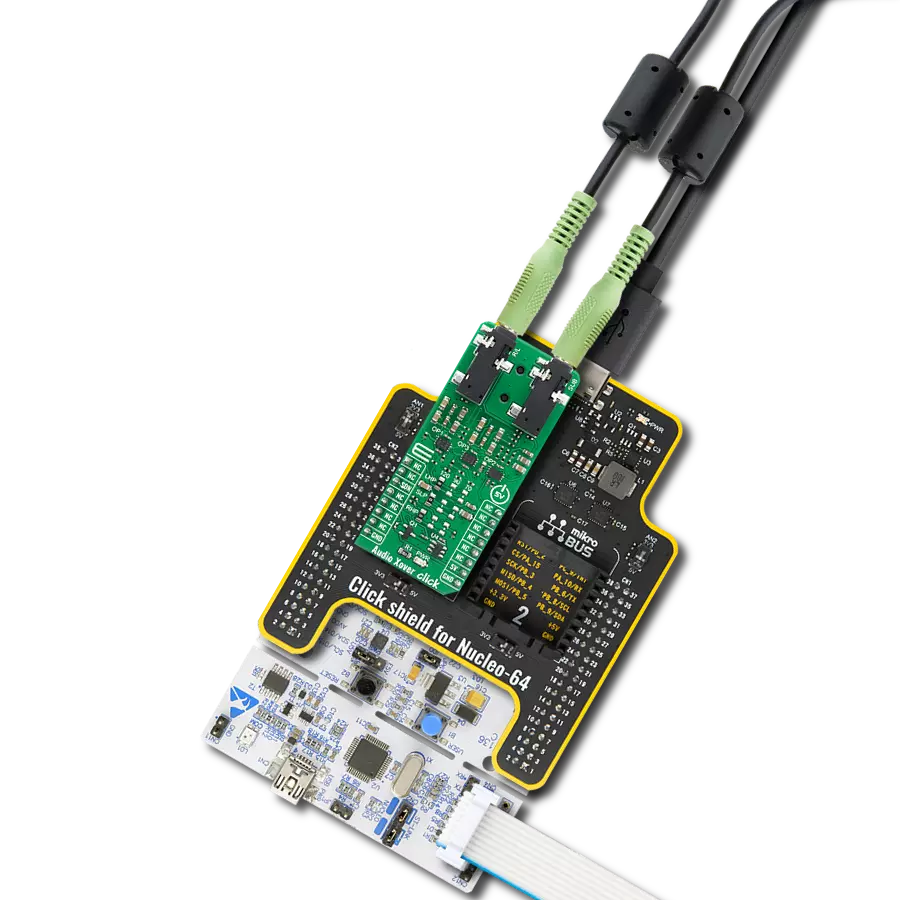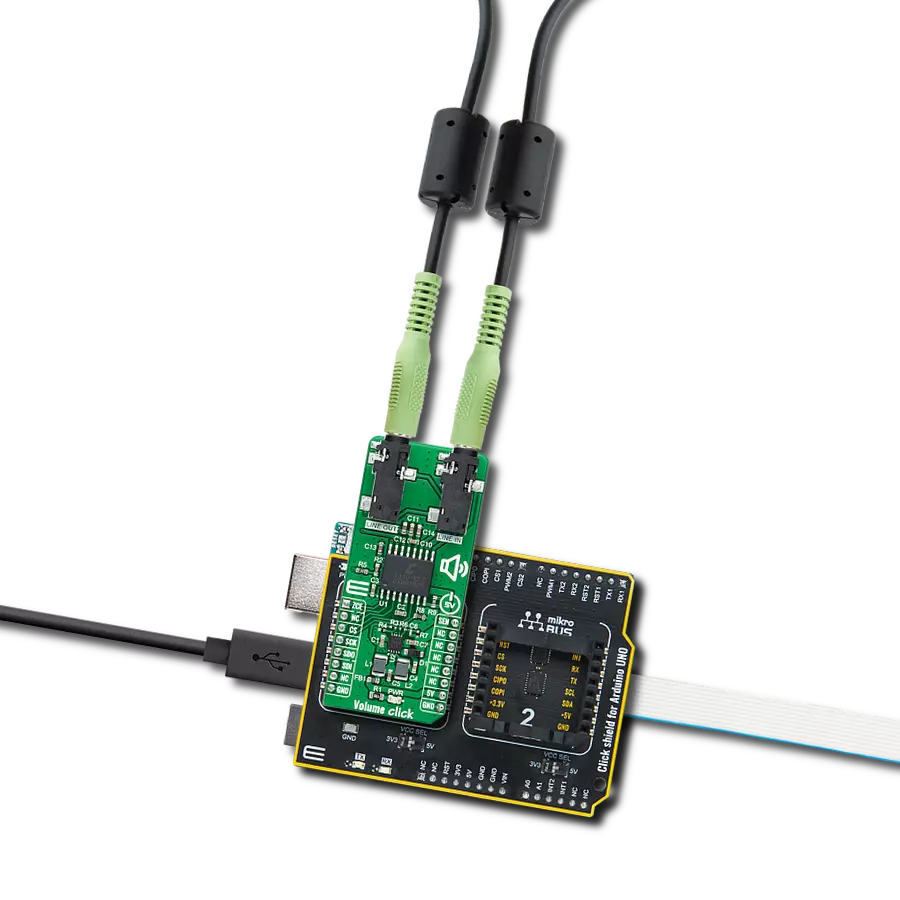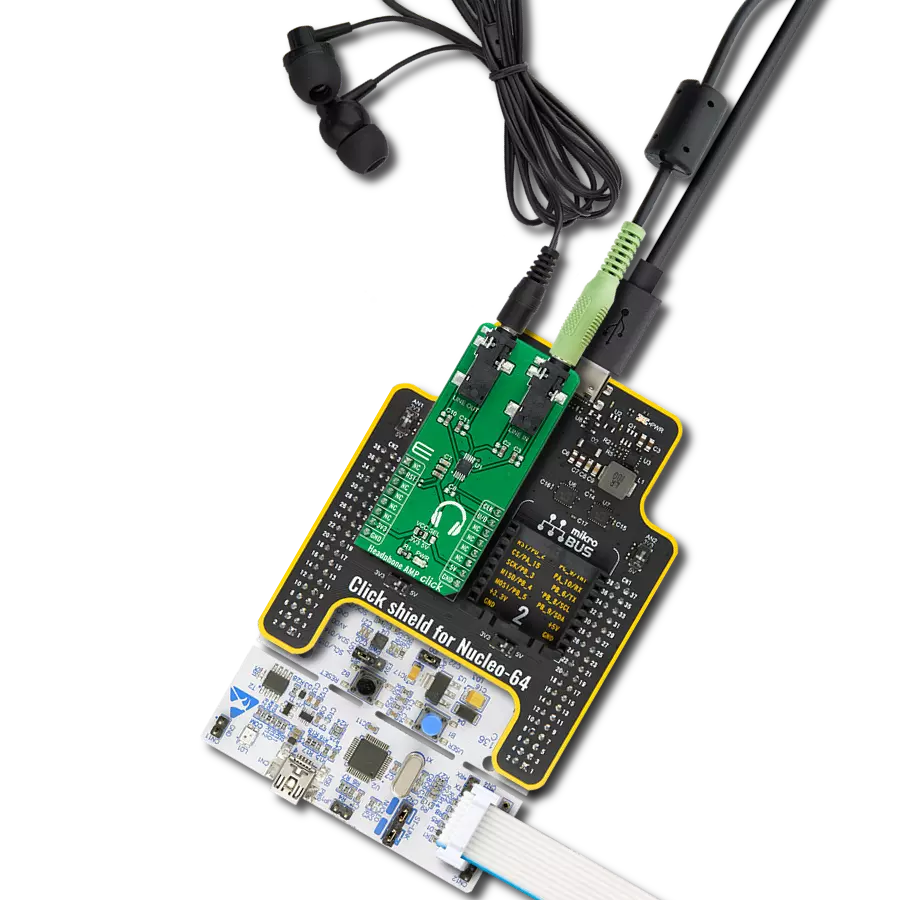Experience the true power of your headphones with our amplifier, designed to maximize every detail and bring your music to life like never before
A
A
Hardware Overview
How does it work?
Headphone AMP Click is based on the LM4811, a stereo, analog input headphone amplifier with digital volume control from Texas Instruments. This headphone amplifier is designed to provide high-quality output power using few external components and does not require bootstrap capacitors or snubber networks for stability improvement. The maximum power delivered by the LM4811 headphone amplifier is 105mW per channel into 16Ω and 70mW with 16Ω load impedance. Other prominent features of the ML4811 also include digital volume control, "Click and Pop" suppression circuitry, and a low shutdown current of 0.3μA. This Click board™ communicates with MCU using several GPIO pins.
The signals from the CLK and U/D pins routed to the PWM and INT pins of the mikroBUS™ socket control the LM4811's gain. The gain will increase or decrease by a 3dB step depending on the logic voltage level applied to the U/D pin at each rising edge of the CLK signal. A logic high voltage level applied to the U/D pin causes the gain to increase by 3dB at each rising edge of the CLK signal and vice versa. The amplifier's gain is set to a default value of 0dB upon the devices' Power-On features. Sixteen discrete gain settings range from +12dB maximum to −33dB minimum. The unity-gain stable LM4811 also features an externally controlled, active-high, micro-power consumption Shutdown mode, available on the RST pin of the
mikroBUS™ socket, to reduce power consumption while not in use. However, when coming out of Shutdown mode, the LM4811 will revert to its previous gain setting. Alongside all these features, the LM4811 also has an internal thermal shutdown protection mechanism. This Click board™ can operate with either 3.3V or 5V logic voltage levels selected via the VCC SEL jumper. This way, both 3.3V and 5V capable MCUs can use the communication lines properly. Also, this Click board™ comes equipped with a library containing easy-to-use functions and an example code that can be used as a reference for further development.
Features overview
Development board
Arduino UNO is a versatile microcontroller board built around the ATmega328P chip. It offers extensive connectivity options for various projects, featuring 14 digital input/output pins, six of which are PWM-capable, along with six analog inputs. Its core components include a 16MHz ceramic resonator, a USB connection, a power jack, an
ICSP header, and a reset button, providing everything necessary to power and program the board. The Uno is ready to go, whether connected to a computer via USB or powered by an AC-to-DC adapter or battery. As the first USB Arduino board, it serves as the benchmark for the Arduino platform, with "Uno" symbolizing its status as the
first in a series. This name choice, meaning "one" in Italian, commemorates the launch of Arduino Software (IDE) 1.0. Initially introduced alongside version 1.0 of the Arduino Software (IDE), the Uno has since become the foundational model for subsequent Arduino releases, embodying the platform's evolution.
Microcontroller Overview
MCU Card / MCU

Architecture
AVR
MCU Memory (KB)
32
Silicon Vendor
Microchip
Pin count
28
RAM (Bytes)
2048
You complete me!
Accessories
Click Shield for Arduino UNO has two proprietary mikroBUS™ sockets, allowing all the Click board™ devices to be interfaced with the Arduino UNO board without effort. The Arduino Uno, a microcontroller board based on the ATmega328P, provides an affordable and flexible way for users to try out new concepts and build prototypes with the ATmega328P microcontroller from various combinations of performance, power consumption, and features. The Arduino Uno has 14 digital input/output pins (of which six can be used as PWM outputs), six analog inputs, a 16 MHz ceramic resonator (CSTCE16M0V53-R0), a USB connection, a power jack, an ICSP header, and reset button. Most of the ATmega328P microcontroller pins are brought to the IO pins on the left and right edge of the board, which are then connected to two existing mikroBUS™ sockets. This Click Shield also has several switches that perform functions such as selecting the logic levels of analog signals on mikroBUS™ sockets and selecting logic voltage levels of the mikroBUS™ sockets themselves. Besides, the user is offered the possibility of using any Click board™ with the help of existing bidirectional level-shifting voltage translators, regardless of whether the Click board™ operates at a 3.3V or 5V logic voltage level. Once you connect the Arduino UNO board with our Click Shield for Arduino UNO, you can access hundreds of Click boards™, working with 3.3V or 5V logic voltage levels.
These standard small stereo earphones offer a high-quality listening experience with their top-notch stereo cable and connector. Designed for universal compatibility, they effortlessly connect to all MIKROE mikromedia and multimedia boards, making them an ideal choice for your electronic projects. With a rated power of 100mW, the earphones provide crisp audio across a broad frequency range from 20Hz to 20kHz. They boast a sensitivity of 100 ± 5dB and an impedance of 32Ω ± 15%, ensuring optimal sound quality. The Φ15mm speaker delivers clear and immersive audio. Cost-effective and versatile, these earphones are perfect for testing your prototype devices, offering an affordable and reliable audio solution to complement your projects.
Used MCU Pins
mikroBUS™ mapper
Take a closer look
Click board™ Schematic

Step by step
Project assembly
Software Support
Library Description
This library contains API for Headphone AMP Click driver.
Key functions:
headphoneamp_set_sound_volume- Headphone AMP set sound volume functionheadphoneamp_volume_up- Headphone AMP set sound volume up functionheadphoneamp_volume_down- Headphone AMP set sound volume down function
Open Source
Code example
The complete application code and a ready-to-use project are available through the NECTO Studio Package Manager for direct installation in the NECTO Studio. The application code can also be found on the MIKROE GitHub account.
/*!
* @file main.c
* @brief Headphone AMP Click Example.
*
* # Description
* This library contains API for the Headphone AMP Click driver.
* This demo application shows use of a Headphone AMP Click board™.
*
* The demo application is composed of two sections :
*
* ## Application Init
* Initialization of GPIO module and log UART.
* After driver initialization the app set default settings,
* performs power-up sequence, sets a the sound volume of -12 dB.
*
* ## Application Task
* This is an example that shows the use of Headphone AMP Click board™.
* The app performs circles the volume from -12 dB to 3 dB back and forth,
* increase/decrement by 3dB.
* Results are being sent to the Usart Terminal where you can track their changes.
*
* @author Nenad Filipovic
*
*/
#include "board.h"
#include "log.h"
#include "headphoneamp.h"
static headphoneamp_t headphoneamp; /**< Headphone AMP Click driver object. */
static log_t logger; /**< Logger object. */
void application_init ( void )
{
log_cfg_t log_cfg; /**< Logger config object. */
headphoneamp_cfg_t headphoneamp_cfg; /**< Click config object. */
/**
* Logger initialization.
* Default baud rate: 115200
* Default log level: LOG_LEVEL_DEBUG
* @note If USB_UART_RX and USB_UART_TX
* are defined as HAL_PIN_NC, you will
* need to define them manually for log to work.
* See @b LOG_MAP_USB_UART macro definition for detailed explanation.
*/
LOG_MAP_USB_UART( log_cfg );
log_init( &logger, &log_cfg );
log_info( &logger, " Application Init " );
// Click initialization.
headphoneamp_cfg_setup( &headphoneamp_cfg );
HEADPHONEAMP_MAP_MIKROBUS( headphoneamp_cfg, MIKROBUS_1 );
if ( headphoneamp_init( &headphoneamp, &headphoneamp_cfg ) == DIGITAL_OUT_UNSUPPORTED_PIN )
{
log_error( &logger, " Application Init Error. " );
log_info( &logger, " Please, run program again... " );
for ( ; ; );
}
headphoneamp_default_cfg ( &headphoneamp );
log_info( &logger, " Application Task " );
Delay_ms ( 100 );
log_printf( &logger, "-------------------------\r\n" );
log_printf( &logger, " Performs Power-up\r\n" );
headphoneamp_power_up( &headphoneamp );
Delay_ms ( 100 );
log_printf( &logger, "-------------------------\r\n" );
log_printf( &logger, " Set volume gain -12dB\r\n", HEADPHONEAMP_SOUND_VOLUME_NEG_12_dB );
headphoneamp_set_sound_volume( &headphoneamp, HEADPHONEAMP_SOUND_VOLUME_NEG_12_dB );
log_printf( &logger, "-------------------------\r\n" );
Delay_ms ( 1000 );
Delay_ms ( 1000 );
Delay_ms ( 1000 );
Delay_ms ( 1000 );
Delay_ms ( 1000 );
}
void application_task ( void )
{
for ( uint8_t n_cnt = 0; n_cnt < 5; n_cnt++ ) {
log_printf( &logger, " Turning volume up\r\n" );
headphoneamp_volume_up ( &headphoneamp );
Delay_ms ( 1000 );
Delay_ms ( 1000 );
}
log_printf( &logger, "-------------------------\r\n" );
Delay_ms ( 1000 );
Delay_ms ( 1000 );
Delay_ms ( 1000 );
Delay_ms ( 1000 );
Delay_ms ( 1000 );
for ( uint8_t n_cnt = 0; n_cnt < 5; n_cnt++ ) {
log_printf( &logger, " Turning volume down\r\n" );
headphoneamp_volume_down ( &headphoneamp );
Delay_ms ( 1000 );
Delay_ms ( 1000 );
}
log_printf( &logger, "-------------------------\r\n" );
Delay_ms ( 1000 );
Delay_ms ( 1000 );
Delay_ms ( 1000 );
Delay_ms ( 1000 );
Delay_ms ( 1000 );
}
int main ( void )
{
/* Do not remove this line or clock might not be set correctly. */
#ifdef PREINIT_SUPPORTED
preinit();
#endif
application_init( );
for ( ; ; )
{
application_task( );
}
return 0;
}
// ------------------------------------------------------------------------ END
Additional Support
Resources
Category:Signal Processing





































